Birds
Media
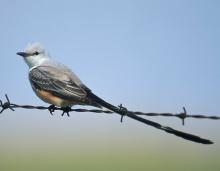
Species Types
Scientific Name
Tyrannus forficatus
Description
One of Missouri’s most breathtaking birds, the scissor-tailed flycatcher captures insects in midair, then flits back to its perch. You’re most likely to see it in summer, in our southwestern prairies.
Media
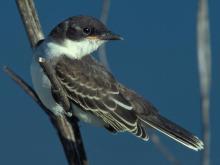
Species Types
Scientific Name
Tyrannus tyrannus
Description
The eastern kingbird’s spirited territorial defense, tidy, black-and-white plumage, and distinctive, fluttery flight have long captured the attention and admiration of people.
Media
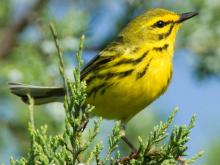
Species Types
Scientific Name
Setophaga discolor (formerly Dendroica discolor)
Description
The prairie warbler has yellow underparts with black streaks on the sides. It lives in dry shrubby glades and old fields with scattered shrubs and red cedars — not in prairies.
Media
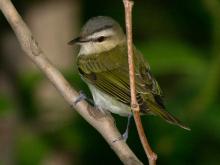
Species Types
Scientific Name
Vireo olivaceus
Description
Singing an incessant series of question-and-answer homilies from dawn to dusk, even through the hottest of summer days, the red-eyed vireo has been called the “preacher bird.”
Media

Species Types
Scientific Name
Setophaga dominica (formerly Dendroica dominica)
Description
The yellow-throated warbler creeps along branches high in the tops of trees, searching the bark for insects. Listen for its distinctive song, a cascade of clearly whistled tew notes.
Media

Species Types
Scientific Name
Coccothraustes vespertinus
Description
Evening grosbeaks are sporadically present in Missouri — flocks sometimes wander here from the north during winter. When flocks appear at backyard birdfeeders, it creates a local sensation.
Media
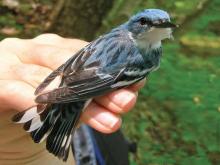
Species Types
Scientific Name
Setophaga cerulea (formerly Dendroica cerulea)
Description
A summer resident in Missouri, the cerulean warbler is more common in the southeastern Ozarks but rare elsewhere in the state. Its numbers are small and declining, and for that reason our nation may soon classify it as endangered.
Media
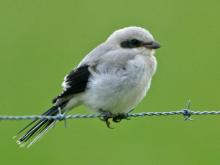
Species Types
Scientific Name
Lanius ludovicianus
Description
This robin-sized, gray and white bird has a black eye-mask extending behind its large, hooked bill. It has the unusual habit of hanging its prey items — little birds, mice, frogs, and big insects — on tree thorns or barbed wire.
Media
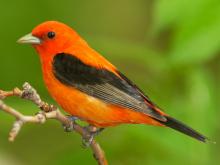
Species Types
Scientific Name
Piranga olivacea
Description
In summer, scarlet tanagers feed on insects and fruit in the canopy of oak-hickory forests and in large shade trees of the eastern U.S. and southern Canada.
Media

Species Types
Scientific Name
Euphagus carolinus
Description
Missourians most often see rusty blackbirds during spring and fall migration, though in southern Missouri they sometimes stay through the winter. Look for them foraging in pastures and fields near water.
See Also







Media

Species Types
Scientific Name
Hemaris diffinis
Description
The snowberry clearwing is a moth that confuses people because it looks like a bumblebee and flies like a hummingbird!
Media

Species Types
Scientific Name
Hyles lineata
Description
The white-lined sphinx moth sometimes confuses people because it flies, hovers, and eats from flowers like a hummingbird. The adults often fly during daylight hours as well as in the night and are often found at lights.
Media

Species Types
Scientific Name
Darapsa myron
Description
The Virginia creeper sphinx moth is common in woods and brushy areas and comes to lights at night. The larvae eat Virginia creeper and grape leaves.
Media

Species Types
Scientific Name
Perimyotis subflavus (formerly Pipistrellus subflavus)
Description
Tri-colored bats, formerly called eastern pipistrelles, are relatively small and look pale yellowish or pale reddish brown. The main hairs are dark gray at the base, broadly banded with yellowish brown, and tipped with dark brown.
Media

Species Types
Scientific Name
Myotis grisescens
Description
Gray myotises are difficult to distinguish from other mouse-eared bats. A key identifying feature of the gray myotis is that its wing is attached to the ankle and not at the base of the toes. It’s an endangered species.
Media

Species Types
Scientific Name
Myotis lucifugus
Description
The little brown myotis (little brown bat) is one of our most common bats, but populations are declining. White-nose syndrome has taken a heavy toll in northeastern states. This species is now listed as vulnerable across its range.
Media

Species Types
Scientific Name
Myotis sodalis
Description
The Indiana myotis, or Indiana bat, summers along streams and rivers in north Missouri, raising its young under the bark of certain trees. It is an endangered species.
About Birds in Missouri
About 350 species of birds are likely to be seen in Missouri, though nearly 400 have been recorded within our borders. Most people know a bird when they see one — it has feathers, wings, and a bill. Birds are warm-blooded, and most species can fly. Many migrate hundreds or thousands of miles. Birds lay hard-shelled eggs (often in a nest), and the parents care for the young. Many communicate with songs and calls.





















